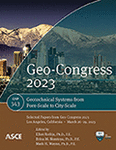The Effect of Joint Width on the Performance of Interlocking Block Pavements
Publication: Geo-Congress 2023
ABSTRACT
Interlocking block pavement (IBP) consists of discrete blocks, joint and bedding sands, base, and subbase. Among others, joint sand plays an important role in the overall performance of an IBP, because it facilitates the load transfer between the blocks. Previously, researchers have performed IBP model test in order to determine the appropriate joint width. The proposed value, however, varies depending on the researchers because the geotechnical information (relative density and shear strength) of the joint sands is often neglected and not clearly defined. Therefore, in this study, a laboratory block pavement test was carried out by varying the joint width while considering the geotechnical properties of the paving materials. In addition, the model test was conducted in a newly designed 2D model chamber which enables particle image velocimetry (PIV) analysis. The test results show that the IBP settlement resistance and load dispersion ability are greater for IBPs with narrow joint widths owing to their higher load transfer efficiency (LTE).
Get full access to this article
View all available purchase options and get full access to this chapter.
REFERENCES
AH, N. H., Nor, H. M., and Azman, M. (2014). Effect of jointing sand sizes and width on horizontal displacement of concrete block pavement. Jurnal Teknologi, 71(3).
ASTM. (2018). ASTM C33/C33M–11 Standard specification for concrete aggregates. Pennsylvania: ASTM.
ASTM. (2020). ASTM D2940/D2940M-20 Standard Specification for Graded Aggregate Material for Bases or Subbases for Highways or Airports.
Ascher, D., Lerch, T., Oeser, M., and Wellner, F. (2006). 3D-FEM simulation of concrete block pavements. In: The 8th international conference on concrete block paving sustainable paving for our future. San Francisco, USA: Interlocking Concrete Pavement Institute (ICPI); p. 457–65.
ASTM. (2018). ASTM C144-18, Standard Specification for Aggregate for Masonry Mortar. Annual book of ASTM standards.
Bowman, A. J., and Haigh, S. K. (2019). Subsurface deformation mechanisms beneath a flexible pavement using image correlation. Géotechnique, 69(7), 627–637.
Clifford, J. M. (1984). A description of “Interlock” and “Lock-up” in block pavements. In Second International Conference on Concrete Block Paving, Delft (pp. 10–12).
Huurman, M. (1997). Permanent deformation in concrete block pavements. Ph.D. thesis, Delft Univ. of Technology, Delft, The Netherlands.
Knapton, J., and O’Grady, M. (1983). Structural Behaviour of Concrete Block Paving. Journal Concrete Society. 17–18.
Knapton, J. (1994). Port and industrial pavement design with concrete pavers. A comprehensive guide. Shoukry, S. N., William, G. W., and Riad, M. Y. (2005). Evaluation of load transfer efficiency measurement (No. WVU-2002-04). Pennsylvania Transportation Institute, Pennsylvania State University.
Kuipers, G. (1992). The effect of concrete block lock-up on pavement performance. In Proceedings of the 4th International Conference on Concrete Block Paving (CBP’92) (Vol. 1, pp. 51–59).
Lilley, A. A., and Dowson, A. J. (1988). Laying course sand for concrete Block Paving. In Proc. 3rd International Conference on Concrete Block Paving (pp. 457–462).
Ling, T. C., Nor, H. M., and Hainin, M. R. (2009). Properties of concrete paving blocks incorporating crumb rubber and SBR latex. Road Mater Pave Des, 10(1): 213–222.
Lin, W., Kim, D., Ryu, S., Hao, H., Ge, Y. E., and Cho, Y. H. (2018). Evaluation of the load dissipation behavior of concrete block pavements with various block shapes and construction patterns. Journal of Materials in Civil Engineering, 30(2), 04017291.
Mahapatra, G., and Kalita, K. (2018). Effects of interlocking and supporting conditions on concrete block pavements. Journal of The Institution of Engineers (India): Series A, 99(1), 29–36.
Mudiyono, R. (2015). The effect of paver joint width on the construction of concrete block pavement on sloping road section. In International Conference on Coastal and Delta Areas (Vol. 1, No. 2, pp. 77–82).
Muller, R. M., Motta, L. M. G., and Medina, J. (2006). Evaluation of the thickness of joints in transmission of stress and displacements in an experimental panel of ICBP. In Proceedings of the 8th International Conference on Concrete Block Paving, San Francisco, CA, USA (pp. 6–8).
Panda, B. C., and Ghosh, A. K. (2002). Structural Behaviour of Concrete Block Paving I: Concrete Blocks. Journal of Transportation Engineering. (April).130–135.
Qiao, Y., Dawson, A., Huvstig, A., and Korkiala-Tanttu, L. (2015). Calculating rutting of some thin flexible pavements from repeated load triaxial test data. Int. J. Pavement Engng 16, No. 6, 467–476.
Shackel, B. (1985). Evaluation, design and application of concrete block pavements. In Third International Conference on Concrete Pavement Design and Rehabilitation. Purdue University, School of Civil Engineering; Federal Highway Administration; Portland Cement Association; Transportation Research Board; Federal Aviation Administration; and Indiana Department of Highways. (No. 1 Volume).
Shoukry, S. N., William, G. W., and Riad, M. Y. (2005). Evaluation of load transfer efficiency measurement. Pennsylvania Transportation Institute, Pennsylvania State University.
Soutsos, M. N., Tang, K., Khalid, H. A., and Millard, S. G. (2011). The effect of construction pattern and unit interlock on the structural behaviour of block pavements. Construction and Building Materials, 25(10), 3832–3840.
White, D., Randolph, M., and Thomsan, B. (2005). Image Based Deformation measurement system for geotech centrifuge.pdf. Int. J. Phys. Model. Geotech., 01–12.
Yaginuma, H., and Kasahara, A. (2006). Load transfer efficiency in interlocking block pavements with joint and bedding sand. In Concrete Block Paving 7th International Conference, Proceedings (pp. 421–431).
Information & Authors
Information
Published In
History
Published online: Mar 23, 2023
Authors
Metrics & Citations
Metrics
Citations
Download citation
If you have the appropriate software installed, you can download article citation data to the citation manager of your choice. Simply select your manager software from the list below and click Download.
